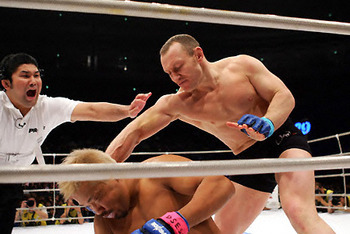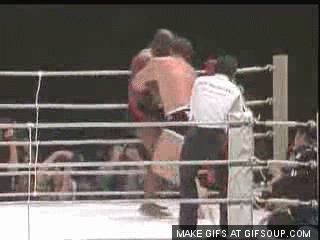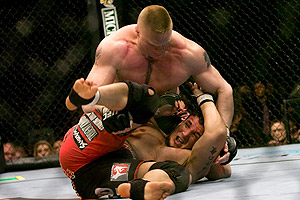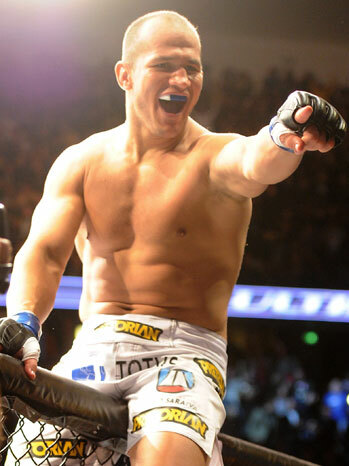
The heavyweight division has traditionally been sparse on talent. Yet with the upcoming all heavyweight spectacular at UFC 146, all eyes are focused on the division and fans are more excited for a card as a whole than they have been for some time. Perhaps people think that they are excited because the heavyweight division is ever improving, and the men competing today would trounce the heavyweight division of three or four years ago? Probably not. The reason most fans are excited is because the heavyweight division promises FINISHES. Big ones.
Why You Buy Heavyweight Fights
Heavyweight fights have always been viewed as the ticket sellers, which is why the atrocious Frank Mir vs Cro Cop match up (replacing the only slightly less atrocious Frank Mir vs Big Nog 2 match up) was still able to headline a UFC event, despite a wealth of talent elsewhere on the the same card. People pay to see heavyweights because big men can generate a lot of force in their punches, tend to have a harder time covering up (due to their massive frames) and gas so quickly that a knockout delivered by the second man to tire is pretty much assured.
When heavyweight matches go the scheduled distance however, they tend to be open mouthed panting, clinched against the fence affairs which put a dampener on the whole evening of fights. Sean Sherk vs Evan Dunham was a back and forth technical exchange with significant ramifications at lightweight, buried in the memory of fans beneath 3 rounds of Frank Mir failing to take down an opponent who was 30lbs lighter than him, with an injured eye.
Much of the talk three years ago, when Fedor Emelianenko had turned down the opportunity to fight for the UFC, was around the "new breed" of heavyweights. Men just as skilled as Fedor who were bigger, and a marked improvement on anything that had come at heavyweight before. How much of this "new breed" was hype? We'll examine that below.
The New Breed: Fact or Fiction?
Fedor Emelianenko, wherever you stand on his legacy, is the single best rounded heavyweight to have had major success in MMA. HIs stand up was the best in the division, his clinch work was also world class and he was equally dominant from the top and from his back. In addition to this he was one of the few heavyweights in the world to not visibly have trouble with going the distance. He has declined massively since his heyday, and from his fight with Tim Sylvia onward seemed to only want to swing wild at his opponents, but none have matched his effectiveness in all areas. In order to understand just how routine the "new breed" of heavyweights are when compared to the standard set by The Last Emperor, it is necessary to examine them one by one.
Brock Lesnar and Shane Carwin: When forum members and MMA journalists spoke of the "new breed" in the heavyweight division, they always used the generic example of the "big wrestler". And by this they usually meant Brock Lesnar or Shane Carwin. Brock Lesnar made his way to the UFC heavyweight title with no skill other than his wrestling, which had severely decayed since his dominating NCAA Division I run.

The assertion that this "big wrestler" with relentless top control would be able to smother and pound out anyone in the heavyweight division was more based in the imaginations of fans than in reality. Brock Lesnar's takedown success rate was just 57%, most of which came against only semi-competent wrestlers Heath Herring and Frank Mir. Factor in that of Lesnar's 11 career takedowns, Couture stood up again twice and Velasquez stood up again twice. Only 7 of Lesnar's takedowns were of any effect. 5 of these takedowns also came against a washed up Heath Herring, who Brock was unable to finish. Impressive strength? Hell yes. But not the modern Smashing Machine that we were promised.
Shane Carwin's takedown percentage meanwhile is just 29%. That's not too bad when you consider that Carwin's M.O is to stand and bang, but aside from a crisp 1-2 he wasn't the most technically proficient at this. Gabriel Gonzaga was able to put him on the brink of a TKO loss with a half foot reach disadvantage and limited punching ability himself. Carwin was able to rally admirably against Gonzaga and KO the Brazilian moments later, but a man with an 80 inch reach should never be in trouble on the feet. Carwin has a ton of heart, as demonstrated against Junior dos Santos, but his cardio, if anything, is worse than old school heavyweight gassers Kevin Randleman, Mark Coleman, Mark Kerr.
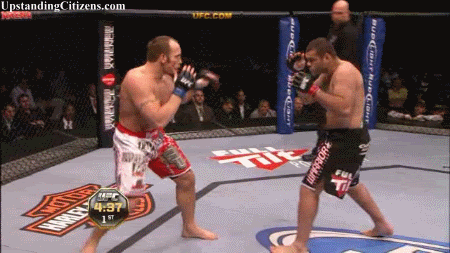
Both Lesnar and Carwin were intimidating presences in the octagon... but not in any way a "new breed". Mark Kerr was ragdolling opponents and then gassing out ten years before these guys.
Cain Velasquez: A relentless wrestler who can also kickbox well. Or so it seemed. But a closer inspection of his three biggest fights, against Kongo, Lesnar and Dos Santos reveal an inability to get away from punches that removes all suggestion of his being the best rounded heavyweight in MMA. Cheick Kongo threw about five real punches in his fight with Cain Velasquez, while running backwards, and dropped the American twice. Brock Lesnar, a horrific striker, was also out jabbing Cain Velasquez until he realized that he hated being hit. Junior dos Santos finished Cain's night as Cain turned his back on Junior's overextended, sloppy overhand so that it connected on the back of his head.
Cain Velasquez can do it all on offense, but hasn't learned to defend himself adequately on the feet just yet. His amazing cardio is the main argument for his being an improvement on the original heavyweight model, and it's a convincing one. But he is one of the smallest heavyweights in the UFC, which counters the notion that big wrestlers are the future of the division.
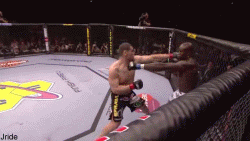
Following the dos Santos fight, in which Cigano had to do no defending of takedowns and knocked Cain out with a sloppy overhand, there is little argument that even at this late, brawling exclusively stage of his career, Fedor couldn't knock Cain out.
Cain Velasquez puts in one of the best cases for being "new breed", but ultimately is just a skilled light heavyweight who doesn't like cutting weight.
Frank Mir: Frank Mir deserves a lot of respect for what he has attempted to do with his career. In the PRIDE years he was seemingly unwanted by the largest organisation in the sport and carved out a niche submitting heavyweight also-rans. But since then he has attempted to improve his stand up relentlessly and has had decent success doing so.
The only issue is that striking wasn't Frank's main weakness. His weakness, as displayed by Pe de Pano, Ian Freeman and later Brock Lesnar, was getting stuck on the bottom and pounded out when he used all his strength on a failed submission. He lacks the positional game of a Nogueira or a Werdum, who are able to sweep or simply stand up from a takedown, rather than sit under the opponent eating punches.
Then there is Frank's wrestling, failing to take down a decayed Cro Cop despite a 30lbs weight advantage is fairly bad, but to be out muscled by Nogueira in the clinch is just bizarre.

An entertaining finisher who often puts on great fights, but Mir's rounded game is an illusion brought about by fighting terrible opposition. If Big Nog and Cro Cop are still looking passable against him (and even rocking him) a decade after they lost to Fedor, he can hardly be considered a "new breed".
Junior dos Santos: An astounding fighter, but hardly a case for well rounded heavyweights. Competent takedown defense and rumored excellent Jiu Jitsu, Cigano has still showed signs of gassing in his fights with Roy Nelson and Shane Carwin (it just so happened that they gassed worse). Cigano's success with two or three punching combinations in the heavyweight division really just demonstrates how lackluster the standard of kickboxing there still is. The fact that a decent boxer with an average sprawl sits atop the heavyweight division is damning to the idea of a new breed.
A spectacular finisher, and the owner of some of the fastest, heaviest hands in MMA, but hardly "new breed". Sprawl and brawlers have been around for years, he's just Andre Arlovski before Arlovski's chin declined.

Cheick Kongo: I don't think I need to go in to detail as to why Cheick Kongo isn't a well rounded heavyweight. He's a kickboxer who lacks boxing ability.
Alistair Overeem: A powerful submission grappler, a world class kickboxer and a 265lbs collosus, nobody makes the case for being a "new breed" of heavyweight as well as Alistair Overeem does. He is, however, a new acquisition of the UFC, and not one of fighters who had been hyped as well rounded by Zuffa for the last three years.
Conclusions
Ultimately the new breed is almost entirely a myth, (you might well have noticed my failure to even mention Todd Duffee, once marked to be the next big thing in the UFC's rebranded heavyweight division). We have a top quality match up for the heavyweight title coming up between Overeem and dos Santos, but it is not the battle of well rounded athletes that others are making it out to be. It is simply one of the few times that two competent strikers have met at the top of the heavyweight division. The sad truth is that Overeem (barring a moment of stupidity in which he fights in the only place where JDS can win) will probably choose to grind Cigano out on the ground or against the cage, and that will be another "new breed" heavyweight's lack of depth exposed.
There are a handful of better rounded, fairly well conditioned heavyweights in the UFC, but that has always been the case with the division. The rest are still the same cut and paste punchers who end up panting by the end of the first round, and swinging with their hands by their knees by the third. But isn't that what makes heavyweight fights entertaining?
Ultimately the new breed is almost entirely a myth, (you might well have noticed my failure to even mention Todd Duffee, once marked to be the next big thing in the UFC's rebranded heavyweight division). We have a top quality match up for the heavyweight title coming up between Overeem and dos Santos, but it is not the battle of well rounded athletes that others are making it out to be. It is simply one of the few times that two competent strikers have met at the top of the heavyweight division. The sad truth is that Overeem (barring a moment of stupidity in which he fights in the only place where JDS can win) will probably choose to grind Cigano out on the ground or against the cage, and that will be another "new breed" heavyweight's lack of depth exposed.
There are a handful of better rounded, fairly well conditioned heavyweights in the UFC, but that has always been the case with the division. The rest are still the same cut and paste punchers who end up panting by the end of the first round, and swinging with their hands by their knees by the third. But isn't that what makes heavyweight fights entertaining?
